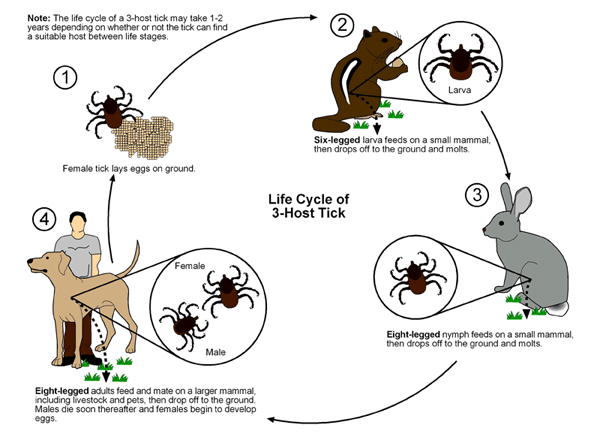[vc_row][vc_column][vc_column_text]
The Wood Tick

The Dog Tick, Dermacentor variabilis, in its splendor of beet overtones and resistance to vilification. By Sam Droege, Flickr [CC BY 2.0]
If you notice a tick on you or believe you have a tick infestation on your property, make sure you act quickly to prevent a dangerous situation.
HOW TO IDENTIFY WOOD TICKS
These ticks (technically arachnids and related to spiders) have four pairs of legs that let them crawl among the brush as well as on your skin. These species grow up to five millimeters in length, with females being close to twice the size of male species.
Both genders have gray patterns on their bodies, but females patterns can grow up to a centimeter and a half after they have fed upon a host.
Appearance and Behavior

The lifecycle of a 3-host hard tick, based on Dermacentor variabilis (American dog tick). Illustration by: Scott Charlesworth, Purdue University, Medical Entomology Extension. Own work [CC BY-SA 4.0]
American dog ticks prefer to bite dogs, and are often transferred to humans in the home in this nature.
However, if the ticks do not bite onto a host first, it is unlikely that they will move into a residence, as they prefer being outside.
If a tick bites you, the skin around the bite will likely become red, swollen, and inflamed. It will also probably itch. Try not to touch it, and if the area becomes more infected, or if you begin to experience other symptoms, visit a doctor as soon as possible.[/vc_column_text][/vc_column][/vc_row][vc_row][vc_column][vc_column_text]
HOW DO YOU GET WOOD TICKS
Most people pick up ticks when hiking or moving about in tall grass or wooded areas. It is also common for pets to pick up ticks in this fashion.
If you wear short pants or short sleeve shirts, you are even more likely to pick up a tick, as it does not have to navigate through layers of clothing.
Ticks are often found in warm, damp areas of your body, as they gravitate towards heat. Common places to find a tick include beneath your knee and elbow folds, as well as in your groin. [/vc_column_text][/vc_column][/vc_row][vc_row][vc_column][vc_column_text]
HOW TO GET RID OF WOOD TICKS
Ticks are most commonly found in brushy, overgrown areas. Keeping your lawn mowed and your brush cleared can help reduce the likelihood that you will contract a tick. In severe cases, you can also apply a broad-based insect repellent or insecticide to your lawn.
When hiking or spending time in the woods, make sure you keep all exposed skin covered. When possible, apply an insect repellent containing DEET to any exposed areas, or on top of your clothing.
If you happen to get a tick on you, don’t try to pull it out with your bare fingernails. Instead, use fine-tipped tweezers to grasp it as close as possible. Try not to break the body of the tick while it’s still embedded in your skin, as this can increase the likelihood of contracting a disease.
You might also consider contacting a pest control technician to evaluate the severity of the tick problem at your home. If you have come into contact with multiple ticks already this season, it might be time to consider a broad insect control plan that will get rid of these ticks and also prevent them from recurring. A pest control specialist will be able to work with you to decide what kind of plan will best suit your needs.
Wood Tick Diseases
Wood ticks don’t usually take up residence inside your home, but they can cause more problems than just about any other pest combined. Ticks feed on your blood, and in the process of doing so transmit a variety of tick-borne severe diseases.
Common diseases caused by American dog ticks include Rocky Mountain spotted fever, tularemia, and Colorado tick fever. These diseases can present many troublesome symptoms that in some cases can be fatal.[/vc_column_text][/vc_column][/vc_row][vc_row][vc_column][vc_separator][vc_column_text]
Tick Articles
[catlist name=”ticks”][/vc_column_text][/vc_column][/vc_row][vc_row][vc_column][vc_empty_space][/vc_column][/vc_row]